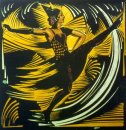|
In painting our eye, in music our ear, in architecture our space-perception, in dance the body is the way of the art ...
(Aleksej Sidorov, 1922).
Last Monday, the beautiful esposition entitled At the beginning there was the Body... The Art of Movement in Moscow had opened his door in the charming liberty of the Acquario Romano. The event is promoted by the Assessorato alle Politiche Culturali del Comune di Roma and it has been introduced by the councilman Gianni Borgna. It presents extraordinary pieces unknown to specialists. Nicoletta Masler, the curator, has used a notable, philologic survay to realize the work.
The esposition is dedicated to the artistic research through body-language and to the activity of Choreographyc Workshop of Russian Academie of Scientific Arts at the beginning of the century. A big number of photographic finds is gathered with some original draws about movement studies and sketches, from public and privat archives.
The event will be a moment of rediscovering and comprension of a forgiven artistic moment. This is fundamental for contemporary history of art because the total searching research of new languages had passed russian landmarks to take european breathing. The same intent was divided by all the artists from Choreographyc Workshop borned in 1920 and directed by Aleksej Sidorov and Aleksandr Larionov.
Both spokesman of the Symbolism, they collaborated with Vasilij Kandinskij at the Istitute of artistic culture of Moscow and at the Russian Academie of artistic sciences. Years before, Kandinskij had descripted a new way of sintetic art, the art of movement: "It's necessary to establish a relationship between the movement of the line and the movement of the total human body...and to translate in a line the body movement ...".
Research of new way of expression brought to a marvelous syntesis of arts. In the exposition, the observer can find draws by Oton Engels to airy, coreographic images created by Kas'jan Golejzovskij, from Aleksandr Rumnev's expressive research to Lev Lukin's plastic innovations. In the rounded Acquario, the movement on the images looks like a big kaleidoscope. Moving on, you can observe painting, sculpture, draw, dance and theatre like a movie film.
The art of photography conquers a place apart. At the beginning of the century russian photography was stimulated by the Academy of artistic sciences. In fact, after the first world war and the civil war, this structure sponsored the Russian Photographic Society. With new stimulus the laboratory trasformed itself in a big centre for artistic and scientific elaborations based on the study of the motion; the human body movements were divided in three parts: artistic movement, work movement and physical education's motion.
A first exposition based on those results was presented in 1925. The character of the event was private, caused by fear for politic objections about nude - studies.
Two other events followed the first version of Art of movement. Sections were dedicated to archeological-artistic studies and the beautiful images created by Sidorov finally appeared. Unfortunately with social-political changing, in 1930, russian photographic society was dispersed, accused of middle class-art.
From 23 march to 24 april, the exposition will offer notable performances, on the line of the contest. Concerts of contemporary russian music and choreography made of italian groups that continue russian experments will be presented.
Michele Pogliani, the companies Kinkaleri and Teatri del Vento, Silvana Barbarini, Lucia Latour and Vera Stasi will be some guests. Omage to the principal figure of Isadora Duncan will be offered by Raffaella Giordano. Contacts between russian and italian dance were intense from century beginning. From 1916 Diaghilev often sojourned in Italy, where he begun a collaboration with the Futurism and the musician Ottorino Respighi.
For musical section muscovite Igor Nikonovich will play Skrjabin's works and Trio Roslavets from Moscow Conservatory will present works by Roslavets, Prokofiev, Rachmaninov, Mosolov e Sostakovic.
Acquario Romano
Rome - P .zza Manfredo Fanti, 47
Bibliography
- Misler, N., a c., In principio era il corpo... l'arte del movimento a Mosca negli anni '20, Catalogo della Mostra, Electa, 1999
- De Micheli, M., Le avanguardie artistiche del Novecento, Feltrinelli, 1994
- Parnach, V., Balletts anciens, balletts modernes, in "L'amour de l'Art", I, gennaio 1931
- Piccione, C., Gli italiani e i Ballets russes, in "La danza italiana", vol. 7, E.C.D.D., 1989
|
 fig. 1
fig. 1